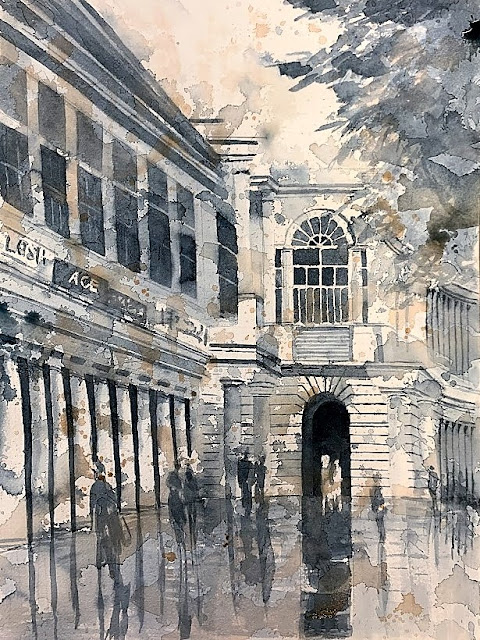The history of a painting
I've been studying Kate Osborne's still life watercolors - they are simply stunning. I have tried copying a few - and it is very interesting when you try to copy something. You need to understand its history. Luckily, in watercolor, you can reverse engineer the whole process. By looking deeply at a painting, you can try to figure what was the last layer of strokes before the painting was completed, what came before that, what came before that, and what might have been the first layer. In one painting, she used a technique of blooming/maybe dry brushing that I spent all of Saturday happily trying to replicate. I got pretty close, but I don't know if that is what she actually did or she has another trick up her sleeve.
So, in studying the history of some of her still lifes, I was able to experiment with the way she layers, her techniques, and trying to get this effect or that. It is a good way to understand what an artist's technical process is - and the different watercolor effects they might prefer. BUT it does not teach you to HOW to see, crop, or choose composition or color. She had already done that work - by looking at a bunch of beets, she decided which ones to paint, perhaps how to arrange them just so, how to run them off the edge of the paper, and the color choices she made. I don't know what she left out - and she must have edited some.
Technique, of course, is a major part of a painting, but an equally important part is how you translate what you see in reality to this beautiful watercolor, that will hopefully far exceed your subject.
So, I've been experimenting with still life - how do I correct what I see, what color choices do I make. All this has to be done before technique even begins.
For the next few days, for lack of better subjects, I have decided I will try to paint loose still lifes - practicing techniques, messing up, risking it, just playing - with items from the home, and from images on the web of everyday objects.
So, in studying the history of some of her still lifes, I was able to experiment with the way she layers, her techniques, and trying to get this effect or that. It is a good way to understand what an artist's technical process is - and the different watercolor effects they might prefer. BUT it does not teach you to HOW to see, crop, or choose composition or color. She had already done that work - by looking at a bunch of beets, she decided which ones to paint, perhaps how to arrange them just so, how to run them off the edge of the paper, and the color choices she made. I don't know what she left out - and she must have edited some.
Technique, of course, is a major part of a painting, but an equally important part is how you translate what you see in reality to this beautiful watercolor, that will hopefully far exceed your subject.
So, I've been experimenting with still life - how do I correct what I see, what color choices do I make. All this has to be done before technique even begins.
For the next few days, for lack of better subjects, I have decided I will try to paint loose still lifes - practicing techniques, messing up, risking it, just playing - with items from the home, and from images on the web of everyday objects.




Comments
Post a Comment